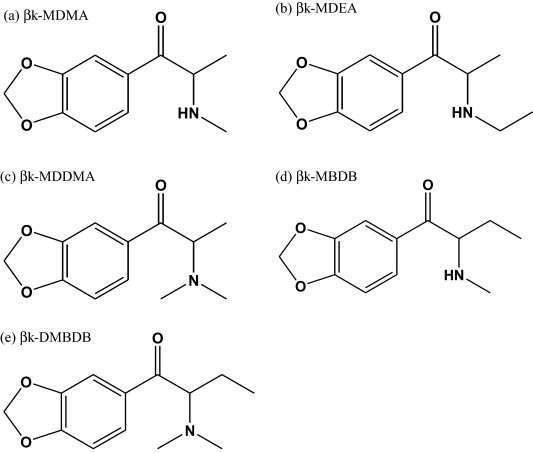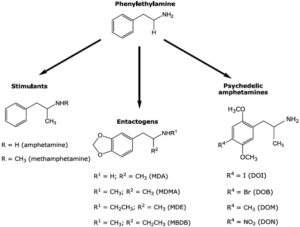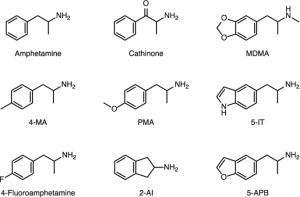
MDMA analogues
MDMA is a semi-synthetic drug belonging to the group of phenylethylamines. The chemical structure of the substance allows it to be classified as an amphetamine stimulant, although it is more correct to consider it an empathogen. To date, there are a large number of different products that are sold under the name “ecstasy”, not to mention a multitude of analogs.
Changes in the “ecstasy” market
MDMA – 3,4-methylenedioxymethamphetamine – is the most popular club drug of the last century. Initially, it was the one that was included in “ecstasy”, so over time these definitions became identical. Consumption is accompanied by excessive activation of neurotransmitter systems in the brain, due to which the concentration of serotonin and dopamine increases sharply. On the background of mild stimulation of psychovegetative functions, experiences and empathogenicity increase, euphoria appears with parallel suppression of fear and anxiety.
In recent decades, hundreds of new synthetic drugs have begun to spread in the underground environment. They have similar effects to MDMA, so they are often sold under the guise of “ecstasy” tablets. Thus, consumers can never be sure what kind of substance or “cocktail” they received from the dealer.

MDMA analogues
Intake of most phenylethylamines eventually leads to depletion of neurotransmitter depots, manifested by “serotonin syndrome”. The main reason for MDMA use is euphoria and empathogenicity. Other psychoactive substances may also possess these properties to varying degrees. Any drug is capable of causing side effects, leading to specific health consequences.
Methylone
MDMC (bk-MDMA) is a synthetic amphetamine-type stimulant that acts similarly to MDMA. On the illicit market it is known as “explosion” or “liquid ecstasy”. In its original form it is a powdered substance, but is distributed as oral liquids.
However, it is a stretch to call Methylone a club drug. Its effects resemble MDMA, but due to structural differences, it has more antidepressant properties than psychedelic properties.
MDEA
Another representative of amphetamine empathogens is 3,4-methylenedioxy-N-ethylamphetamine – MDEA. On the streets, it is known as “Eve” or “Intellect.” It is manufactured from the same precursors as MDMA, so the mechanism of action is the same.
The standard dose is about 100-200 mg, clinical effects develop in 20-60 min when taken orally, persisting for up to 5 hr. Its effect on the body is not as psychedelic (“no magic”) and long-lasting as that of MDMA. At the same time, the stimulation is more pronounced and side effects are less, according to users’ feedback.
MDA and BDB
MDA – tenamphetamine – is a synthetic empathogen from the group of phenylethylamines, which is often found in “ecstasy” tablets. In general, its effects are very similar to MDMA, but the effects persist a bit more, especially the stimulant effects. Users note stronger psychedelic properties, but the “withdrawal” afterwards is worse.
For one intake usually goes from 80 to 150 mg of the product. The main analog of alpha-ethyl MDA is BDB (BDB, J), which is used in a larger dose – 150-230 mg. Listed as Schedule I banned substances are.
MBDB and butylone
MBDB, known as eden, Methyl-J, has a similar structure to MDMA. The substance has milder and slower onset of effects, euphoria and stimulation are weakly expressed. It is unpopular as a stand-alone drug, but is often included in combination products.
The beta-keto analog of MBDB is butylone. It is taken in a similar dose – from 50 to 150 mg orally. The action is even weaker and shorter (up to 3 h). In susceptible users, psychostimulation resembles amphetamine stimulation, but with a touch of psychedelia.

Other amphetamines
There are many derivatives of phenylethylamine, which is able to affect neurotransmitter systems. Their properties are affected by the substitution of methyl groups in the formula and the position of the molecule in space (isomers). The following analogs of MDMA are distinguished:
- amphetamine
- methamphetamine
- mephedrone
- cathine
- cathinone
- para-methoxymethamphetamine (PMMA, PMA)
- 4-methylthioamphetamine (4-MTA)
Thus, practically all amphetamine-type stimulants have similar effects. However, the severity of the leading classes of effects is correlated differently. Some species have stronger psychostimulation, while others have empathogenic properties. In excessive doses, hallucinations may occur.

Thank you for the clear information. The cathinones are new to me in my research on chemicals that increase dopamine , so I’ll be reading some of your other blogs to understand why chemicals can’t be water soluble! My chemistry is limited to base and alkaloids.